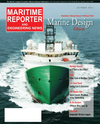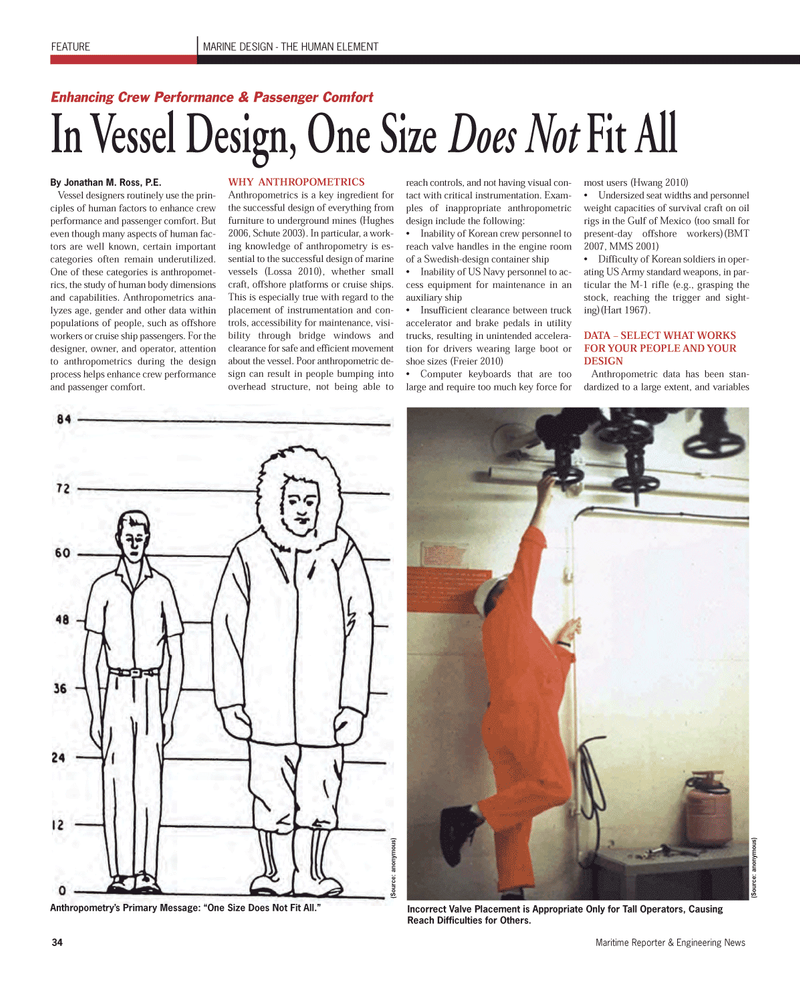
Page 34: of Maritime Reporter Magazine (October 2011)
Marine Design Annual
Read this page in Pdf, Flash or Html5 edition of October 2011 Maritime Reporter Magazine
By Jonathan M. Ross, P.E. Vessel designers routinely use the prin- ciples of human factors to enhance crew performance and passenger comfort. Buteven though many aspects of human fac- tors are well known, certain important categories often remain underutilized. One of these categories is anthropomet- rics, the study of human body dimensionsand capabilities. Anthropometrics ana- lyzes age, gender and other data withinpopulations of people, such as offshore workers or cruise ship passengers. For the designer, owner, and operator, attention to anthropometrics during the designprocess helps enhance crew performance and passenger comfort. WHY ANTHROPOMETRICS Anthropometrics is a key ingredient for the successful design of everything from furniture to underground mines (Hughes 2006, Schute 2003). In particular, a work- ing knowledge of anthropometry is es- sential to the successful design of marinevessels (Lossa 2010), whether small craft, offshore platforms or cruise ships. This is especially true with regard to the placement of instrumentation and con-trols, accessibility for maintenance, visi-bility through bridge windows and clearance for safe and efficient movement about the vessel. Poor anthropometric de- sign can result in people bumping into overhead structure, not being able to reach controls, and not having visual con- tact with critical instrumentation. Exam-ples of inappropriate anthropometricdesign include the following: Inability of Korean crew personnel to reach valve handles in the engine room of a Swedish-design container shipInability of US Navy personnel to ac- cess equipment for maintenance in anauxiliary shipInsufficient clearance between truck accelerator and brake pedals in utility trucks, resulting in unintended accelera- tion for drivers wearing large boot or shoe sizes (Freier 2010)Computer keyboards that are too large and require too much key force for most users (Hwang 2010) Undersized seat widths and personnel weight capacities of survival craft on oil rigs in the Gulf of Mexico (too small for present-day offshore workers)(BMT 2007, MMS 2001) Difficulty of Korean soldiers in oper- ating US Army standard weapons, in par- ticular the M-1 rifle (e.g., grasping thestock, reaching the trigger and sight-ing)(Hart 1967).DATA ? SELECT WHAT WORKS FOR YOUR PEOPLE AND YOUR DESIGNAnthropometric data has been stan-dardized to a large extent, and variables FEATURE MARINE DESIGN - THE HUMAN ELEMENT34Maritime Reporter & Engineering News Enhancing Crew Performance & Passenger Comfort In Vessel Design, One Size Does Not Fit All Incorrect Valve Placement is Appropriate Only for Tall Operators, Causing Reach Difficulties for Others. Anthropometry?s Primary Message: ?One Size Does Not Fit All.? (Source: anonymous) (Source: anonymous) MR Oct.11 # 5 (34-41):MR Template 10/5/2011 12:44 PM Page 34

 33
33

 35
35
